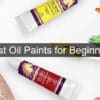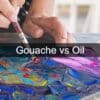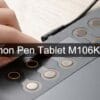Fabric Markers
Best Fabric Markers – All about Permanent Fabric Paint Pens

The easiest way to customize your clothes is by using cloth markers or fabric pens. They’re quick and easy to use, affordable, versatile – they can be used for drawing, coloration, and for writing on most fabrics!
If you’re looking for something that’s going to last, then a fabric marker is the perfect tool. A few simple art supplies are all it takes and your designs will survive through countless washes with ease! Professionals can use these markers too; they just need to be more careful not to leave any marks on clothing while designing.
There are many fabric marker pens on the market, with colors and tip shapes to suit any project. From fine tip and bullet tips to brush tip covering fine lines and thick lines, I’ll go over all of them in this article so you can decide what is right for your creativity.
Just as a little background info for you, I’ve been in illustration for over 20 years, experimenting with a variety of different fabric markers. I now have hundreds in my collection from over 11 brands! In this guide to fabric markers, you’ll learn about all the things that can make your art-making experience better by finding the right marker for your latest project.
Disclaimer – This website contains affiliate links. If you find the information useful and click on a product link and make a purchase, a small commission will be earned by Big Red Illustration
** FEATURED PENS **
What are Fabric Marker Pens?
Fabric painting is a great way to customize materials for all kinds of projects from pillows, t-shirts and more. It’s also easy because you don’t have to worry about cleaning up afterwards! The best fabric markers are another fun option that offers plenty of detail when it comes time to color in your design or write directly onto the fabric.
What you need to know: Pens that are best for writing or detail work on fabric should be permanent. This is why cloth markers contain color ink, paint or dye which will not fade after being washed in the washing machine. If you haven’t already come across these markers, it’s worth knowing about them because they offer more colors than your average marker pen with “permanent” written on their label and can also handle a lot of scrubbing without smudging off like regular felt-tip pens would do!
Permanent markers can be used by anyone and were created to make sure that the use is safe for people of all ages. It’s worth noting that there are fabric markers specifically designed with kids in mind, as they’re made from non-toxic materials and have thicker lines so children’s hands don’t get tired easily while coloring!
- Children’s fabric markers; great to use at school and home
- Adult/hobby: for use on personal clothing projects/fun activities to undertake with the kids
- Illustrators: Always a useful tool to have to hand for any professional
- Artist beginner/artist pro: fabric markers are for anybody who wants to create personalised clothing or fabric art pieces
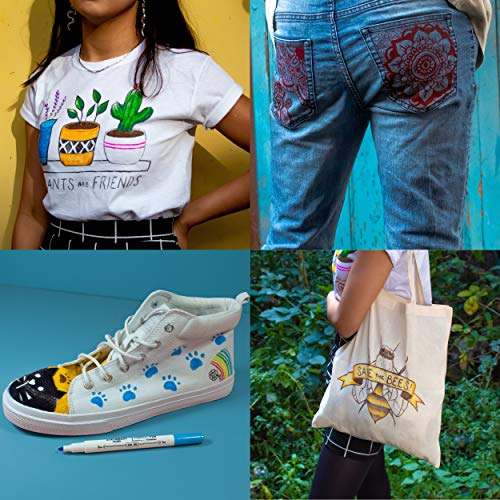
Different Types of Fabric Paint Pens
After deciding what type of fabric you want to mark on, the next step is picking out a suitable marker. Fabric markers come in many different shapes and sizes; some are made specifically for certain types of fabrics like leather or metal surfaces while others can be used across any surface. It’s important that you use the right pen as this will depend greatly on how long your design lasts once it’s been washed off by rain, sweat, tears – natural disasters!
Permanent fabric markers are great for use on fabrics. They will not bleed into the material, dry quickly and stay resistant to fading even after washing them off multiple times.
With so many different types of fabric marker pens to choose from, let’s take a look at the two main categories to help determine the best fabric markers overall. Perm markers will last for years and are fade resistant as long as they are not completely exposed directly to water and sunlight while non-perm markers wear off with time or washing cycles. Below I talk more about these two main types.
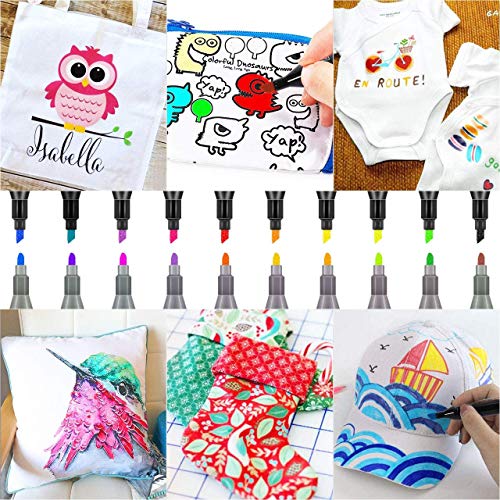
Permanent Fabric Markers
Permanent fabric markers are the best pens to write on any type of fabric. They contain ink, paint or dye inside and once applied it should then be left to dry so that it is permanent. If you want a design for your t-shirt or other types of textile items, this marker will do just fine!
Non-Permanent Fabric Markers
This type of marker is great for when you are short on time and need to create a design that will be removed after your project has been completed. The ink used dries fast so it can easily be erased with water and cloth, making this the perfect tool if you require a sewing design/pattern or want to remove an old design once its job is done.
Fabric Pens Tip Style
There are different types of pen tips that allow you to create thicker or finer lines and details. For example, the fine bullet tips shape (fine point) is great for creating thinner strokes while tilting it a little makes broader strokes. Make sure your fabric pens have brush tips so you can apply them smoothly!
The fine tip bullet pen is ideal for detailed work because it can create more precise lines than thicker tips that would be better suited for larger projects like journaling or artistry. It is always dependant on its use and certain fabrics as to which the best fabric markers are.
However, if you’re looking for something with bolder lines then consider using either a tapered pen which creates broader strokes as well as finer ones when need be or chiselled point pens which offer both broad-stroke quality but also delicate detail making them excellent choices depending on what type of crafts project or fabric types you’re working on.
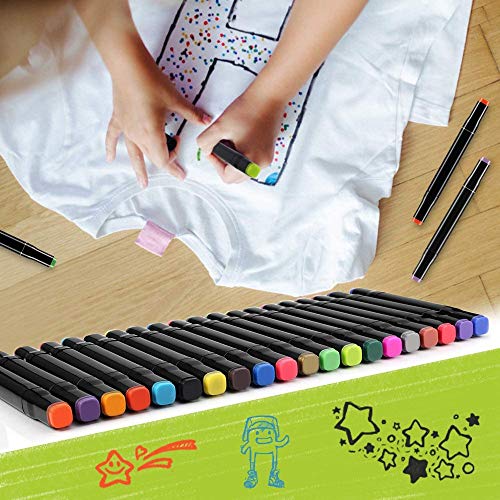
Ink-Based Fabric Pens
Creating using ink fabric pens can be a difficult task when you’re using them for the first time. To avoid accidental mistakes, make sure to work and control these carefully as they will tend to bleed if applied too long in one spot on your project or surface of choice. When drawing with these, light pressure is necessary so that it doesn’t cause bleeding into fabrics which would create an unsightly mess!
You might need to play around with these fabric pens before you find ones that work for your needs. These types of fabric pens not only make it easy to draw on different materials but can also be used on non-porous surfaces like plastic! It’s a good idea to test them out first so as not to waste time and money if the surface is incompatible.
You’ll need to assess what’s important too; is it vibrant colors that resists fading, basic colors, permanent color with a permanent finish, or maybe even the perfect orchid purple? Does it need to be fade proof, have a dual tip or simply be one of the regular markers and have one fine tip?
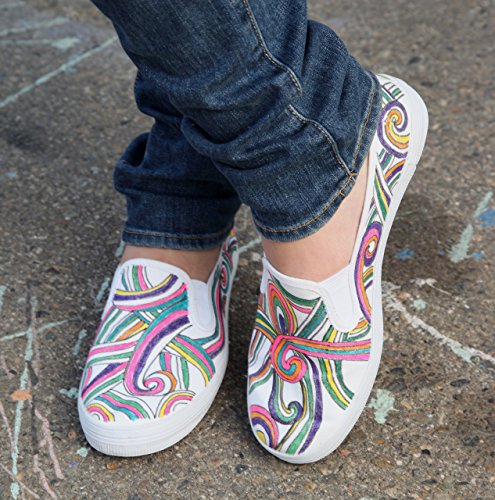
Acrylic Paint Based Fabric Pens
Acrylic Paint Based Fabric Pens are a great way to make your fabric projects pop. They can be difficult to use at first, but once you get used to pumping and shaking the pen before use, it will become easier. Make sure you test these pens out on scrap pieces of material so that when the time comes for your big project, everything goes smoothly! These are great for use on craft projects using dark fabrics and with their vibrant colors are versatile enough to create designs, allow crafts 4 all fabric or pretty much any diy project even including large wall art.
Gel Fabric Pens
Gel pens are a great way to add color and write on fabric. They come in an easy-to-use pen form, suspended with gel ink for long-lasting colors that dry quickly! These pens work best when applied like any other standard pen would be. Gel Pens are fantastic for those just beginning their creative journey because they’re so simple yet so effective!
Selecting Your Fabric Marker Pens
Permanent fabric marker pens are a great way to quickly and easily mark your clothes or other items with no risk of fading. They come in many colors, so you can find one that best suits the needs of what is going on your clothes. This article will highlight a selection of products that should cover your fabric design requirements. If you’re unsure of any pen, the best solution is to try at least two tips on any of your crafts. Alternatively you could trust the ‘best sellers’ listed on reviews.
Fabric Pens Versatility
Fabric markers are great for use on fabric, but if you’re only going to do that once these aren’t the markers for you. For a more versatile option with similar ease of application look into other types as well such as wood or canvas which can be used in addition to your favorite fabrics!
Color and Fabric Pens
These days, you can find numerous fabric pens with over 30 different colors to suit your needs. However, if 12 is enough for what you need, then that’s just as good! You also have the option of choosing color retention; you do not want any fading after only one or two washes!

Tips Size and Type – From Fine Tip To Brush
The world of fabric markers is a vast one, with plenty to choose from. One can find bullet tips or finer tips available that make it easy for the colorist to get just the right amount at their fingertips and use colors like never before! As previously mentioned the range is vast from fine tip and brush tip to elephant gray bullet tip markers and metallic gold, metallic markers. It is however well worth mentioning that dual-tip fabric pens make this experience all too perfect as you are able to create vibrant designs by simply flipping over your pen.
Fabric Pen Quality
Choosing the correct fabric pen is important when working with material. You need to purchase a good quality product, otherwise, you might be risking ink being too thin and bleeding into your fabric which will leave you with an unprofessional design that lacks clear edges. Choosing one that’s either too thin or thick for that matter can lead to uneven absorption of it in the material as well as unclear lines throughout your artwork because they won’t absorb properly.

Fabric Pens and Drying
Fabric marker pens are great for adding artwork to your clothes, but there are a few things you should know before using one. Fabric markers that air-dry will need at least 24 hours of drying time before throwing it in the wash; while fabric markers with the heat on them can withstand being washed and dried right away after setting with an iron.
Fabric Paint Pens and Bleeding
How to keep fabric paint from bleeding? Read the product labels carefully, as some pens will not bleed while others must be set with heat. If it says air-dry on a pen but you’re unsure, throw it into the dryer just for good measure.
Non-Toxic Fabric Pens
If you’re looking to get creative with your DIY projects or maybe just want a way of adorning old clothes, Non-Toxic Fabric Pens are the perfect tool for any project. It’s important that when purchasing these pens it is noted which type they are (toxic/non-toxic) before painting anything and risk ruining clothing items such as baby clothes.
The Pros and Cons of Using Fabric Paint Pens
As you now know, the fabric paint pen is an incredible tool for the custom crafter.
With a variety of highly pigmented, bright colors available on the market today, there are few limits in what diy project one could make with their own hands. Plus thanks to pens that come complete with fine tips or even tiny brushes within them (or even dual tip for that matter), you have endless possibilities as far as creating different designs goes!
However, before investing too deeply into these art mediums here’s some information about both pros and cons:
Fabric Paint Pens Pros
• Great for creating outlines and for work on finer details
• Many brands now offer non-toxic options which are safe to use with kids (always read the label)
• Fabric should not fade when washed as many of the cloth markers are fade-resistant
• Fabric paints can be expensive whereas fabric pens are often far more affordable
• Almost all fabric markers can be used on many types of material or even different surfaces
• For different effects and uses there are a variety of styles for fabric pens ranging from a fine bullet tip to broader and chiselled tips (and of course two tips)
• Fabric markers dry quickly. Some quality brands can naturally dry, whilst others may need ironing
Fabric Paint Pens Cons
• Fabric pens can dry up fairly quickly and therefore may have a short shelf-life. The best practice is to ensure you always replace the cap securely once finished with the pen
• Some cloth markers will bleed into certain materials. The use of a pad may be needed to help prevent this
• Not ideal for larger designs and projects
• There may be limits by certain brands for the sets of fabric markers they supply
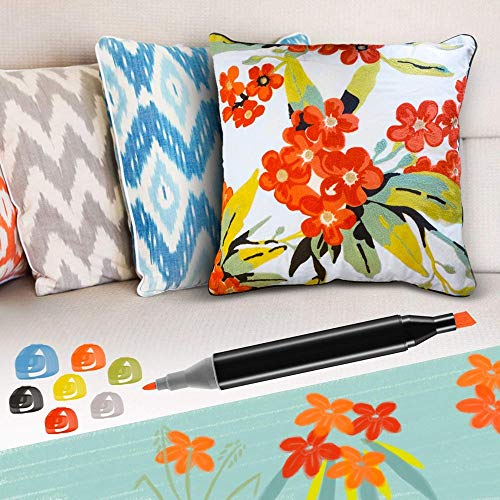
How to use Fabric Pens
Fabric pens are a great way to show off your creativity and have some family fun time together. There are many ways you can use permanent fabric markers, from creating personalized t shirts, with metallic gold designs or styling up other old fabric items such as baby’s onesies or other baby gear. Here are a few other ideas for using the awesome power of fabric pens:
- Fabric Pens and Stencils
Get a set of fabric pens that have fine point bullet tip, these are great to use with stencils (or perhaps a dual tip that includes one). You can easily create beautiful designs on the fabric, simply follow the outline of your pattern carefully for precision artwork. Be sure not to let your stencil design shift around while you work as this will cause more problems than even coloring without it.
- Applying Calligraphy Designs
I love the creative, carefree feeling I get when writing with fabric pens. There is something about how the best markers feel in your hand that makes me want to create beautiful letters and designs on anything around me! It’s such a simple way of expressing yourself via these crafts – all you need are some pen colors and any piece of paper or literally any material could become an art canvas for your detailed designs and artistic expressionism.
- Adding Additional Details
Some designs require much finer details and using a fine brush just might not be as good as a fine-tipped fabric pen. The benefit of the pens is they provide more control over your work, so you will have the ability to produce accurate artwork with them.
- Using Rubber Stamps
Instead of using paint, use a fabric pen to color in your stamps. As you can imagine, this is a much safer alternative when it comes time to stamping the design onto fabric – just make sure not to wait too long before doing so!
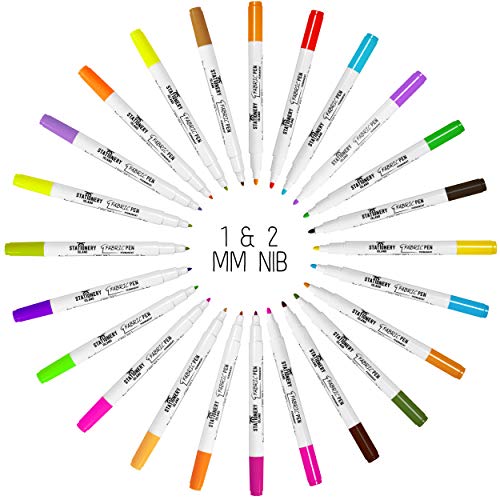
Choosing the Best Fabric For Great Results
The material that you choose to work on is important because it will affect how your final product looks. Choosing a finer grain fabric means there are fewer rough areas in the weave of the cloth and therefore fewer errors or problems while working with this type of fabric than if one were using coarser fabric.
If, for example, you do not know what kind of texture your chosen background has but want to find out before going ahead with designing anything then you can always try testing it first by pressing down lightly over different parts until an error occurs – these small test spots will show up as darker patches when compared against other parts where no problem was found so they act like little maps which help you avoid making mistakes later!
How to Look After Your Fabric Markers
Keeping your fabric marker pens in good condition is important, so here are a few tips on how to do just that:
• Store your fabric markers in a cool, dry, dark place – always!
• Prevent the ink from drying by keeping the pens flat or horizontal
• Keep the lids/caps tightly screwed on
• Shake your fabric pen before use to make sure the ink is activated and ready to go. This is especially important after being stored for a long time
• Prevent bleeding into the fabric by placing a pad between the fabric
• Ensure your fabric has been through the washing machine and completely dry before starting work on it
• Always allow the ink to dry thoroughly on the fabric. And always check to see if it’s an air-dry ink or if you need to apply heat to seal it
Can you Revive Dry Fabric Marker Pens?
The answer to this is yes, fabric pens can be revived. The non-permanent type of markers require soaking in warm water; however, the permanent fabric markers need rubbing alcohol. Take off the cap and submerge it into a container with rubbing alcohol to see some color coming out again!
After rubbing alcohol is applied to the fabric pen, remove it and dry off using a tissue or rag. Next, you take your newly-inked pen and test it on some scrap cloth. After all this preparation you can use your ‘revived’ pens immediately! Remember not to close them with their caps tight because they need time for ink saturation before using them again – so if left standing up will soak in the alcohol after about 24 hours but should be ok within 48 hours (whatever works best for what projects are being worked on).
Please be aware though, this quick solution will not make your fabric pen, like ‘new’. The color quality won’t be the best, and you might see it fading faster because of this method. You can try using alcohol or acetone to inject a small amount directly into the tip of your fiber pen in order to keep them looking newer for longer!

How to use Cloth Markers on a T-Shirt
In order to create designs on t shirts, you will need the following:
• T-shirt of your choice
• Masking tape for temporary protection on areas not being used in the design process. You can also use newspaper or cardboard if masking tape is unavailable. Masking tape should be removed before ironing or sewing as it could cause damage to either surface and may warp fabric during heat application which would make stitching difficult later on; however, other adhesives such as glue stick might work better depending upon project needs)
• Iron with appropriate temperature settings (heat set accordingly to avoid shrinking the fabric). If unsure about specific temperatures needed then err towards lower heats rather than higher ones when setting up garment items or start by ironing the reverse side.
Once ready to begin, your first step is to prep your fabric; wash it and let it dry. If you want before moving on, feel free to test out the pens with another piece of fabric just in case! Place the shirt’s surface flat so that what you’re about to paint faces towards you then hold up a clean sheet of cardboard for protection from any unwanted bleeding if possible. You can use either pen-type tools by creating one design shape at a time (be sure not to touch anything else while painting!) Or if feeling more adventurous, try using brushes combined with dye or paints for an expressive look.
• Trace a pre-printed design directly onto the t-shirt using a fine tip
• You could look to use a stencil (also using a fine tip)
• Go for a freehand design
You can then look to place the masking tape around the edges of your t-shirt to help keep everything in place. Now it’s time for you to get creative! Use fabric pens or paintbrushes, whichever comes handier; just be sure not to add any water at this point as that will make a mess and ruin all your hard work so far.
To make sure the color doesn’t run when dried, leave your newly designed shirt for about five days before removing excess design elements like masking tape or painters’ smocks (beware: these are easily stained!)
A little tip; you can use the freezer paper to prevent stains for a more refined finish. Just place it right up against your fabric as you iron.
Alternatively, you could place your garment on a warm dryer shelf with light heat or leave it to air out after washing – just make sure you set the temperature of your iron according to what type of fabric being used (typically the cotton setting).

Washing Clothes with Fabric Markers
If you’re using a fabric marker for painting, take precautions when washing the clothes afterwards. The markers should be fade resistant and hold their colors for long periods of time to avoid fading (sometimes referred to as light fast). To wash garments that have been painted with fabric pens, it’s best to use either a washing machine or handwash them in order to get rid of the paint stains as much as possible before they leave marks on other clothing items – especially if it’s your favorite shirt!
- You should wait at least 72 hours before you wash your fabric to make sure that the paint has dried completely and all of its details are preserved as intended by design. This is essential because it will ensure the desired appearance does not become muddled with other colors or textures while still wet, which can happen if someone touches anything before then
- Use mild detergent – avoid using soap to help resist fading
- Turn your clothing inside out
- Wash on a gentle wash
- When washing, use cold/warm water. (I recommend the first few washes be cold)
Removing Permanent Fabric Markers
There are two ways you can remove permanent fabric markers from your skin and clothes. You could either clean the area with soap or use alcohol-based remover which is not recommended for materials that do not take well to harsh chemicals.
Removing Permanent Fabric Markers From the Skin
You might have noticed that when you use fabric pens, a bit tends to end up on your skin. You’re not alone; it happens quite often! Usually, this is only an issue for people who are allergic to some ingredients in the pen or stain remover used but don’t worry.
The first way to remove paint from your skin is by using some alcohol. Dip a cotton ball into the rubbing alcohol and wipe it over the paint on your body, then hold for several seconds before wiping off with another dry piece of cotton wool or towel. Alternatively, you can use nail polish remover (acetone) in place of alcoholic liquid; follow the same steps as if you were using an alcoholic solution.
Other methods to remove fabric markers from the skin are:
• Try a little oil, olive, coconut or miner
• Use a salt or sugar scrubber
• Gently scrub with some whitening toothpaste
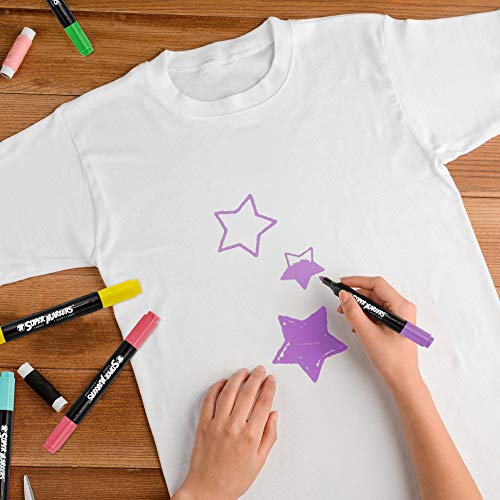
Removing Permanent Fabric Markers From Clothes
Kids are creative and adventurous when it comes to crafts, but sometimes they may have a few accidents in the process. One of those accidents might be getting some marker stains on their clothes! When it comes to this dilemma there are two ways you can go about fixing your problem…
- Rubbing Alcohol
Lay some paper towels down and position the fabric stain face up, then take a sponge to dab rubbing alcohol onto the stains. The ink will start coming off on its own with just one application! For an extra boost of cleaning power, you can use hairspray as well; soak it in high amounts of alcohol first before applying it directly to any stubborn stains.
- Applying Milk
Use milk to clean up fabric marker stains. It’s a safe and easy way! Fill a bowl with some milk, submerge the stain in it (making sure that you cover all of the parts) then let sit for at least 8 hours before washing off.

FAQs
Do fabric pens last a long time?
If you want to use fabric pens for your crafts, it’s important that you know what kind will last the longest. Some brands can hold up for ten hours – that is if your nibs are of good quality.
Can you use fabric paint pens on baby clothes?
Yes, if they are labelled non-toxic, they should be safe to use on baby clothes.
How long does it take for fabric pens to dry?
Leave fabric pen drying for at least 24 hours but 48 hours is recommended. Always read the manufacturer’s directions for more accurate times.
Can washing remove fabric markers?
The best fabric markers are a lot of fun to use, but if you don’t like your creation or want to change it again, later on, there is no going back! Permanent fabric markers should not wash out as they become permanent and set into the fabric. However, with rubbing alcohol some stains can be removed.
Is it Possible to use Fabric Pens on Paper?
Yes, although be aware, with these types of crafts, the paper absorbs a lot more of most fabric markers pen ink and will use up the fabric pen faster.
How can I Increase the Durability of my Fabric Design?
Having applied your design to the fabric, allow it to dry and then seal it with heat using either an iron or a clothes dryer. Iron for about two minutes on high settings or use the low-medium setting for 30 minutes before washing.
Is a Fabric Pen Toxic?
The product label should state that they are toxic or non-toxic, and some even offer certification for use by children.
Is There a Difference Between a Fabric Paint Pen and a Sharpie?
Fabric Pens
As it’s a permanent fabric marker, it can be washed
Designed to work freely over fabric, including detailed designs and crafts
Feature non-bleed properties, especially good with bold colors when more ink may be required for coverage
Sharpie Permanent Fabric Markers (aka sharpie stained fabric markers)
Will color fade with regular washing
Coverage not as good
More inclined to bleed through materials
How to Write on Fabric Without Bleeding?
Fabric paint markers are great for creating fun designs on fabric. Place a piece of cardboard or newspaper behind the design while you work to prevent bleeding in the wash! Do not press too hard and stay too long in one place, otherwise, your colors may start running into each other.
Affiliate Disclosure
In compliance with the FTC guidelines, please assume the following about all links, posts, photos and other material on this website:
Any/all of the links on this website are affiliate links of which The Big Red Illustration Agency receives a small commission from sales of certain items, but the price is the same for you.
www.bigredillustrationagency.com is a participant in the Amazon Services LLC Associates Program, an affiliate advertising program designed to provide a means for sites to earn advertising fees by advertising and linking to Amazon.com & Amazon.co.uk. Pages on this site may include links to Amazon and its affiliate sites on which the owner of this website will make a referral commission.
Cookie preferences: cookie preferences
Adam has made a name for himself in the illustration industry and is a passionate blogger and writer on the subject of art, illustration and graphic design.
His artwork has been featured in countless publications and used for very well-known media projects. As a professional illustrator for over 20 years, Adam's wealth of knowledge and experience enables him to consult and advise artists and illustrators all over the world.
















